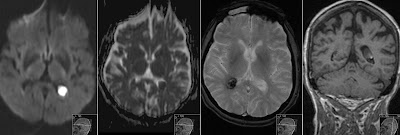CSF Leakage - Intracranial Hypotension

Young woman two weeks after partus followed by spinal pain and stiffness in the neck. Sagittal T2 and contrast enhanced T1 show: sagging of the midbrain as well as cerebellar tonsils, enlarged dural sinuses and hypophysis, steep tentorium. Axial contrast enhanced T1 showing increased dural enhancement and slightly increased subarachnoidal space seen on coronal T2. (BTW: Also note nicely depicted corticospinal tracts on the coronal T2.) Coronal contrast enhanced T1 shows increased dural enhancement as well as sagging of the cerebellar tonsils. Findings strongly suggest Intracranial Hypotension as a consequence of the reduced Cerebro Spinal Fluid (CSF) pressure due to possible CSF leakage associated with lumbar puncture (LP). Differential diagnosis are: 'normal' dural enhancement after LP, as well as meningitis. However meningitis tends to show more subarachnoidal than dural enhancement. See also other case of Intracranial Hypotension from my blog.





